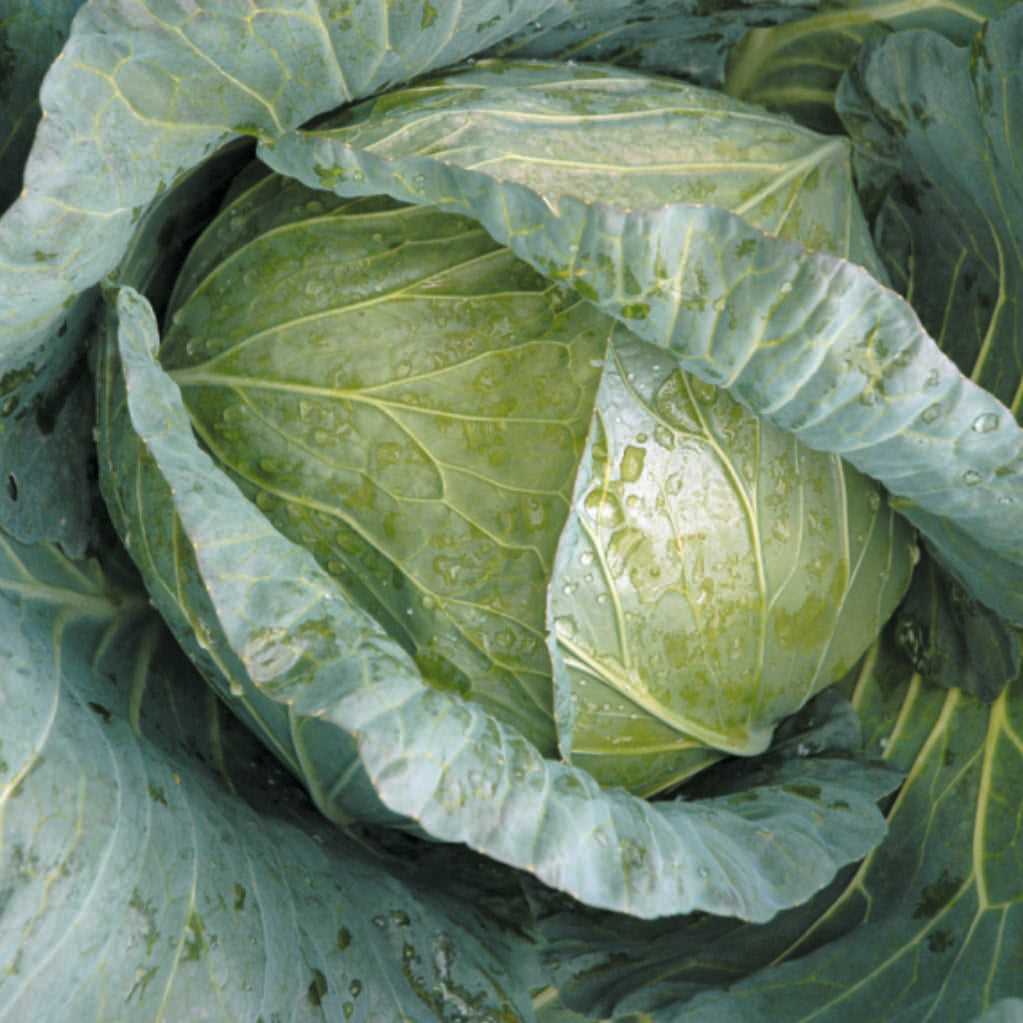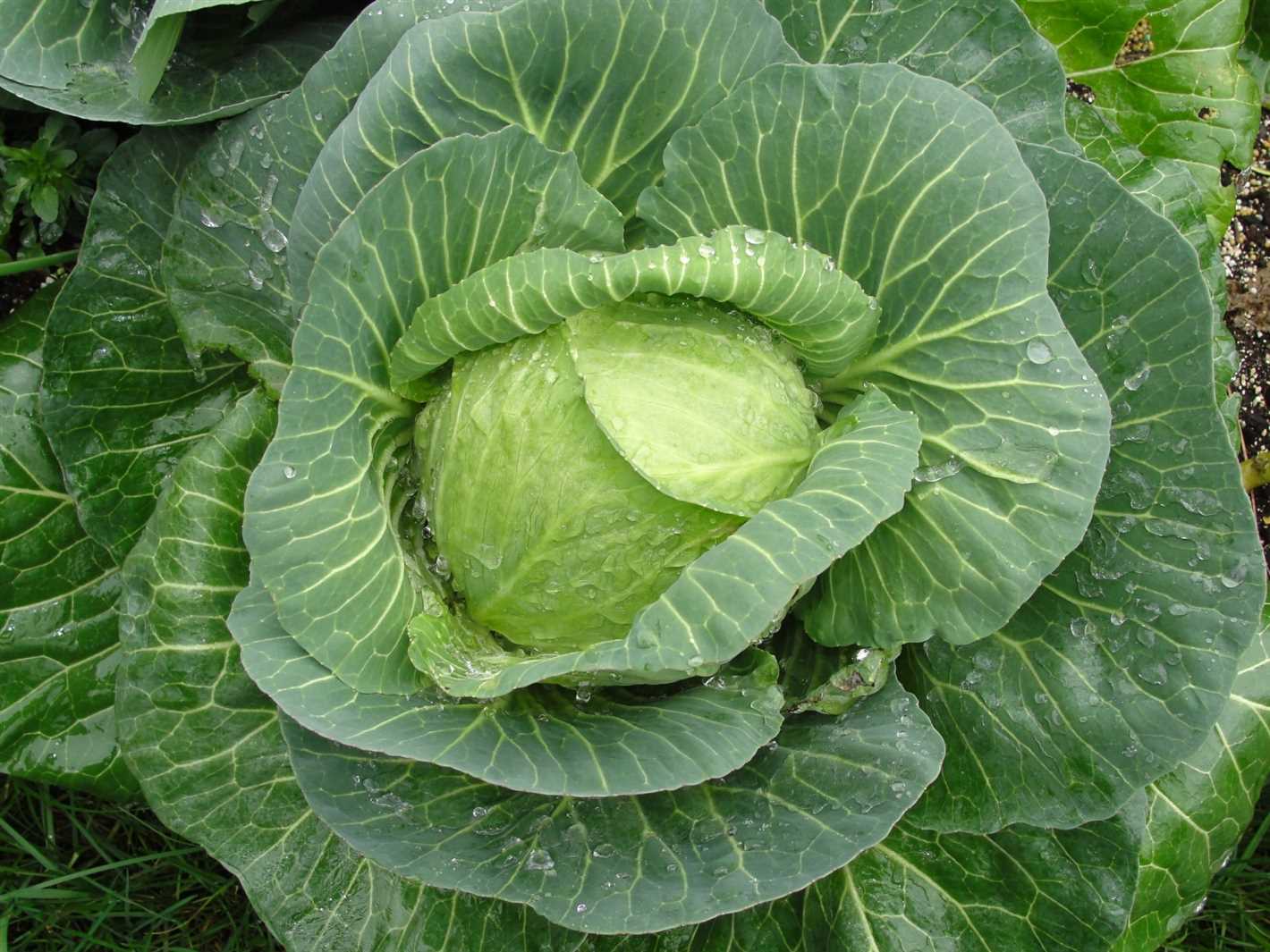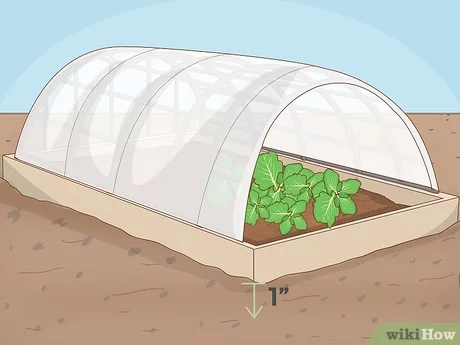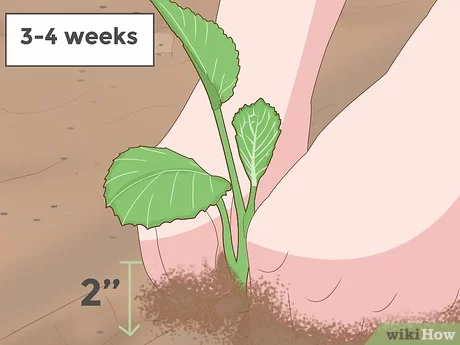- The Grandfather’s Method: Protecting and Feeding Cabbage Seedlings – 2 in 1
- Introduction
- The Grandfather’s Method
- Materials Needed
- Steps
- Benefits of the Grandfather’s Method
- Conclusion
- Why Protecting Cabbage Seedlings is Important
- Pest Control
- Disease Prevention
- Weather Protection
- Optimal Growth and Development
- The Grandfather’s Method for Protecting Cabbage Seedlings
- Step 1: Preparing the Soil
- Step 2: Planting the Seedlings
- Step 3: Mulching
- Step 4: Providing Shade
- Step 5: Watering and Feeding
- Step 6: Pest and Disease Management
- Step 7: Staking and Supporting
- How to Feed Cabbage Seedlings
- 1. Choose the right fertilizer
- 2. Start fertilizing after transplanting
- 3. Apply fertilizer evenly
- 4. Water thoroughly after fertilizing
- 5. Follow the recommended dosage
- 6. Consider organic fertilizers
- The Benefits of the Grandfather’s Method
- When to Start Using the Grandfather’s Method
- 1. Seedling Germination Stage
- 2. Seedling Growth Stage
- 3. Outdoor Transplanting Stage
- 4. Ongoing Care Stage
- 5. Weather Considerations
- Tips for Successful Implementation
- 1. Choose the right cabbage varieties:
- 2. Prepare the soil properly:
- 3. Create protective domes:
- 4. Provide adequate nutrition:
- 5. Water regularly:
- 6. Monitor for pests and diseases:
- 7. Harvest at the right time:
- 8. Rotate crops:
- “Question-Answer”
- What is the Grandfather’s method for protecting and feeding cabbage seedlings?
- Why is it important to protect cabbage seedlings?
- What does the protective cover for cabbage seedlings do?
- What kind of protective cover can be used for cabbage seedlings?
- How does the Grandfather fertilize his cabbage seedlings?
- Why is fertilizing important for cabbage seedlings?
- Can the Grandfather’s method be used for other types of seedlings?
- “Video” Grow calabrese and cabbage for early harvests, use same method for late cropping too
Cabbage seedlings require special care and attention in order to grow into healthy and strong plants. One tried and true method that has been passed down from generation to generation is the Grandfather’s method for protecting and feeding cabbage seedlings.
Grandfather’s method is a two-in-one approach, effectively addressing the two key challenges in cabbage seedling care: protecting the fragile young plants from pests and providing them with the necessary nutrients for growth.
First, protection is essential to shield the cabbage seedlings from insects and other pests that can wreak havoc on their tender leaves. Grandfather’s method employs a combination of organic pest control techniques, such as companion planting and physical barriers. By planting marigolds or onions alongside the cabbage seedlings, the pungent odor repels pests, while also adding a touch of beauty to the garden. Placing row covers or netting over the seedlings adds an extra layer of defense, safeguarding them from hungry critters.
The second aspect of Grandfather’s method is providing proper nutrition to the cabbage seedlings. Cabbage is a heavy feeder and requires nutrient-rich soil for optimal growth. Grandfather recommends enriching the soil with compost or well-rotted manure before planting the seedlings. This ensures a steady supply of organic matter and essential nutrients, such as nitrogen, phosphorus, and potassium, to support their development. Additionally, periodically feeding the plants with a liquid fertilizer, rich in micronutrients, gives them an extra boost.
By combining protection and feeding in one method, Grandfather’s approach provides a holistic solution for healthy cabbage seedlings. Following this time-tested advice can result in strong, resilient cabbage plants, ready to thrive in the garden and provide a bountiful harvest.
The Grandfather’s Method: Protecting and Feeding Cabbage Seedlings – 2 in 1
Introduction
When it comes to growing cabbage seedlings, protecting them from pests and providing them with essential nutrients are two important tasks. Thankfully, there is a simple method that combines both of these tasks into one efficient process. This method, known as “The Grandfather’s Method,” has been handed down through generations and has proven to be effective in protecting and feeding cabbage seedlings.
The Grandfather’s Method
The Grandfather’s Method involves creating a natural barrier around the cabbage seedlings using common household items and organic materials. This barrier not only protects the seedlings from pests but also provides them with essential nutrients as it decomposes.
Materials Needed
- Chicken wire or mesh
- Compost
- Straw or dry leaves
- Organic fertilizer
Steps

- Prepare the planting area by removing any weeds and loosening the soil.
- Shape the chicken wire or mesh into a circular fence around the cabbage seedlings, making sure it is tall enough to protect the seedlings from pests.
- Fill the space inside the fence with compost, leaving a small opening for watering.
- Spread a layer of straw or dry leaves on top of the compost to retain moisture and provide additional protection.
- Water the seedlings regularly through the opening in the fence to keep the compost moist.
- Apply organic fertilizer to the compost periodically to provide the cabbage seedlings with essential nutrients.
Benefits of the Grandfather’s Method
The Grandfather’s Method offers several benefits for protecting and feeding cabbage seedlings:
- Effective pest protection: The chicken wire or mesh acts as a physical barrier against pests such as rabbits, insects, and snails.
- Nutrient-rich environment: The compost provides a nutrient-rich environment for the seedlings, promoting healthy growth.
- Moisture retention: The layer of straw or dry leaves helps retain moisture in the soil, preventing drying out and ensuring the seedlings have access to water.
- Organic and sustainable: The method relies on organic materials and natural processes, making it an environmentally friendly option.
Conclusion

If you are looking for a simple yet effective way to protect and feed your cabbage seedlings, consider trying The Grandfather’s Method. By creating a natural barrier and providing essential nutrients, you can set your cabbage seedlings on a path to healthy growth and a bountiful harvest.
Why Protecting Cabbage Seedlings is Important
Protecting cabbage seedlings is an essential step in ensuring a successful and abundant harvest. Cabbage plants are vulnerable to a variety of threats, including pests, diseases, and environmental factors. By taking proactive measures to protect cabbage seedlings, gardeners can increase their chances of cultivating healthy plants and reaping a bountiful crop.
Pest Control
Pests such as aphids, cabbage worms, and slugs can decimate cabbage seedlings if left unchecked. These insects feed on the tender leaves and stems of the plants, causing damage and stunting their growth. By placing protective barriers and implementing organic pest control methods, gardeners can effectively deter these insects and minimize the risk of infestation.
Disease Prevention
Cabbage seedlings are susceptible to various diseases, including clubroot, blackleg, and fungal infections. These diseases can spread rapidly and lead to wilting, yellowing of leaves, and even death of the plants. By practicing good sanitation, providing adequate spacing, and using disease-resistant varieties, gardeners can reduce the likelihood of diseases affecting their cabbage seedlings.
Weather Protection
Extreme weather conditions, such as frost, heavy rainfall, and strong winds, can be detrimental to cabbage seedlings. Frost can damage the tender leaves, while heavy rainfall can lead to waterlogging and root rot. Strong winds can break or uproot the young plants. By using protective covers, providing sheltered growing locations, and adjusting planting schedules according to the local climate, gardeners can safeguard their cabbage seedlings from weather-related damage.
Optimal Growth and Development

By taking preventive measures to protect cabbage seedlings, gardeners create a conducive environment for optimal growth and development. Healthy and protected seedlings are more likely to establish strong root systems, withstand environmental stressors, and produce high-quality heads. This, in turn, increases the chances of a successful harvest and ensures a plentiful supply of fresh and nutritious cabbage.
In conclusion, protecting cabbage seedlings is crucial for a successful cabbage harvest. By implementing pest control measures, preventing diseases, shielding against adverse weather conditions, and promoting optimal growth and development, gardeners can ensure the health and productivity of their cabbage plants.
The Grandfather’s Method for Protecting Cabbage Seedlings
Cabbage seedlings are vulnerable to a variety of threats, including pests, extreme weather conditions, and diseases. The Grandfather’s Method for protecting cabbage seedlings is a simple and effective way to ensure their survival and promote healthy growth.
Step 1: Preparing the Soil
Before planting the cabbage seedlings, it is important to prepare the soil properly. The soil should be well-drained and rich in organic matter. Add compost or well-rotted manure to improve the soil quality and provide essential nutrients for the seedlings.
Step 2: Planting the Seedlings
Once the soil is ready, it’s time to plant the cabbage seedlings. Dig holes in the soil, keeping a distance of about 18 inches between each hole. Place a seedling in each hole and gently firm the soil around the roots. Water the seedlings immediately after planting to help them settle in.
Step 3: Mulching
Mulching plays a crucial role in protecting cabbage seedlings. Apply a layer of organic mulch, such as straw or shredded leaves, around the base of the seedlings. This will help conserve moisture, suppress weed growth, and regulate soil temperature.
Step 4: Providing Shade
In hot summer months, cabbage seedlings may benefit from some shade to prevent wilting. Erect a simple shade cloth or use natural shade provided by taller plants to protect the seedlings from direct sunlight during the hottest part of the day.
Step 5: Watering and Feeding
Cabbage seedlings require consistent moisture to thrive. Water the seedlings regularly, aiming for about 1 inch of water per week. Avoid overwatering to prevent waterlogged soil, which can lead to root rot. Additionally, fertilize the seedlings once every two weeks with a balanced organic fertilizer to encourage healthy growth.
Step 6: Pest and Disease Management
Regularly inspect the cabbage seedlings for signs of pests and diseases. Remove any affected leaves or plants promptly to prevent the spread of infestation. Use organic pest control methods, such as handpicking pests, applying natural remedies like neem oil or insecticidal soap, or introducing beneficial insects.
Step 7: Staking and Supporting
If necessary, provide support to the cabbage seedlings as they grow. Insert stakes near the seedlings and tie the plants to them with twine or soft plant ties. This will prevent the seedlings from bending or breaking under their weight or from strong winds.
By following The Grandfather’s Method for protecting cabbage seedlings, you can help ensure their success and enjoy a bountiful harvest of delicious and nutritious cabbage.
How to Feed Cabbage Seedlings
Feeding cabbage seedlings is an important step in their growth and development. Providing them with the right nutrients will help them grow strong and healthy, increasing their chances of producing a bountiful harvest. Here are some tips on how to feed cabbage seedlings:
1. Choose the right fertilizer
When choosing a fertilizer for your cabbage seedlings, opt for a balanced formula that provides essential nutrients like nitrogen, phosphorus, and potassium (NPK). A general-purpose fertilizer with an equal NPK ratio, such as 10-10-10 or 20-20-20, is suitable for cabbage seedlings.
2. Start fertilizing after transplanting
Wait until your cabbage seedlings have been transplanted into their final growing location before applying fertilizer. This usually occurs about two weeks after germination. Fertilizing too early can lead to the burning of delicate roots.
3. Apply fertilizer evenly
Spread the fertilizer evenly around the base of each cabbage seedling. Avoid direct contact between the fertilizer and the plant’s stem, as it can cause damage. Gently work the fertilizer into the soil using a hand cultivator or rake.
4. Water thoroughly after fertilizing
After applying fertilizer, water the cabbage seedlings thoroughly to help the nutrients reach the roots. This will prevent fertilizer burn and ensure the nutrients are absorbed by the plants.
5. Follow the recommended dosage
Read the instructions on the fertilizer packaging to determine the recommended dosage for cabbage seedlings. Applying too much fertilizer can harm the plants, while applying too little may result in nutrient deficiencies. Follow the instructions carefully to avoid these issues.
6. Consider organic fertilizers
If you prefer organic methods of fertilization, consider using compost or well-rotted manure. These natural fertilizers provide essential nutrients and improve soil fertility. Apply them around the cabbage seedlings, following the same principles as with synthetic fertilizers.
By following these tips, you can ensure that your cabbage seedlings receive the nutrients they need for healthy growth. Remember to monitor their progress and make adjustments to the fertilization regimen as needed. Happy gardening!
The Benefits of the Grandfather’s Method
The Grandfather’s Method for protecting and feeding cabbage seedlings offers several benefits compared to traditional methods:
- Cost-effective: The Grandfather’s Method uses simple and inexpensive materials, such as glass jars and plastic cups, making it a cost-effective solution for small-scale cabbage farming. This method allows farmers to save money on expensive protective equipment.
- Efficient: By providing both protection and nutrients to the cabbage seedlings, the Grandfather’s Method eliminates the need for separate measures, saving time and effort for the farmer. The seedlings are safeguarded from pests and harsh weather conditions while receiving a continuous supply of nutritious water.
- Natural: Unlike chemical pesticides and fertilizers, the Grandfather’s Method relies on natural processes and materials. It promotes a more environmentally friendly approach to agriculture, reducing the impact on the ecosystem and human health.
- Sustainable: The Grandfather’s Method is sustainable in the long term since it encourages the reuse of materials. Glass jars and plastic cups can be collected and used for multiple growing seasons, reducing waste and promoting a circular economy.
- Accessible: The simplicity of the Grandfather’s Method makes it accessible to all farmers, regardless of their resources or technical knowledge. This method can be easily adopted by small-scale farmers or even home gardeners who want to protect their cabbage seedlings without expensive equipment.
Overall, the benefits of the Grandfather’s Method make it an attractive option for protecting and feeding cabbage seedlings. Its cost-effectiveness, efficiency, natural approach, sustainability, and accessibility make it a practical choice for small-scale farming and gardening.
When to Start Using the Grandfather’s Method
The Grandfather’s Method for protecting and feeding cabbage seedlings can be started at different stages of the growing process depending on the specific needs and conditions of your seedlings. Here are some guidelines to help you determine when to start using this method:
1. Seedling Germination Stage
If you have just planted cabbage seeds and they have not yet germinated, it is not necessary to start using the Grandfather’s Method. During this stage, it is important to keep the soil moist and provide proper light for the seeds to sprout.
2. Seedling Growth Stage
Once your cabbage seeds have germinated and the seedlings have started to grow, you can begin to consider implementing the Grandfather’s Method. This method is particularly beneficial when the seedlings are still small and vulnerable to pests and harsh weather conditions.
3. Outdoor Transplanting Stage
If you have already transplanted your cabbage seedlings outdoors and they are still small, it is a good idea to start using the Grandfather’s Method immediately. This method will help protect the seedlings from pests, such as slugs and snails, as well as provide them with the necessary nutrients for healthy growth.
4. Ongoing Care Stage
Even after the seedlings have grown into mature cabbage plants, you can continue to use the Grandfather’s Method as a preventive measure against pests and to provide additional nutrients to the plants. This method can be used throughout the entire growing season to ensure optimal plant health and productivity.
5. Weather Considerations
It is important to consider the weather conditions in your specific location when deciding when to start using the Grandfather’s Method. If you live in an area with frequent pest problems or unpredictable weather patterns, it may be beneficial to start using this method earlier in the growing process to protect your seedlings.
In conclusion, the Grandfather’s Method can be started at various stages of the cabbage seedling growth process, depending on the specific needs and conditions of your plants. It is important to assess the stage of your seedlings and consider the weather conditions before implementing this method to ensure optimal protection and nourishment for your cabbage plants.
Tips for Successful Implementation
Implementing the Grandfather’s Method for protecting and feeding cabbage seedlings requires careful consideration and attention to detail. Here are some tips to help ensure successful implementation:
1. Choose the right cabbage varieties:
Not all cabbage varieties are suitable for the Grandfather’s Method. Choose varieties that are hardy and resistant to common pests and diseases.
2. Prepare the soil properly:

Before planting cabbage seedlings, make sure to prepare the soil properly. Remove any weeds or debris and add organic matter like compost to improve the soil’s fertility and structure.
3. Create protective domes:
To protect the cabbage seedlings from pests and harsh weather conditions, create protective domes using plastic bottles or milk jugs. Cut off the bottom and place the dome over the seedlings, securing it in the ground.
4. Provide adequate nutrition:
Cabbage seedlings require proper nutrition to grow and thrive. Use a balanced fertilizer to provide essential nutrients like nitrogen, phosphorus, and potassium. Apply the fertilizer according to the recommended dosage.
5. Water regularly:
Water the cabbage seedlings regularly to keep the soil moist but not waterlogged. Avoid overwatering, as it can lead to root rot. Use a watering can or a drip irrigation system for precise watering.
6. Monitor for pests and diseases:
Regularly inspect the cabbage seedlings for any signs of pests or diseases. Common pests include cabbage worms, aphids, and slugs. If you notice any signs of infestation, take appropriate measures to control them, such as using organic insecticides or companion planting.
7. Harvest at the right time:
Harvest the cabbage heads at the right time to ensure maximum flavor and texture. Wait until the heads are firm and compact before harvesting. Cut the heads off at the base of the plant using a sharp knife.
8. Rotate crops:
To prevent the buildup of pests and diseases, practice crop rotation. Avoid planting cabbage in the same spot year after year. Rotate cabbage with other crops from the brassica family.
By following these tips, you can successfully implement the Grandfather’s Method for protecting and feeding cabbage seedlings. Enjoy a bountiful harvest of healthy and delicious cabbage!
“Question-Answer”
What is the Grandfather’s method for protecting and feeding cabbage seedlings?
The Grandfather’s method for protecting and feeding cabbage seedlings is a 2-in-1 solution. He uses a combination of a protective cover and fertilizer to promote healthy growth and protect the seedlings from pests and harsh weather conditions.
Why is it important to protect cabbage seedlings?
It is important to protect cabbage seedlings because they are vulnerable to damage from pests, extreme temperatures, and harsh weather conditions. By providing them with a protective cover, you can create a favorable environment for their growth and ensure their survival.
What does the protective cover for cabbage seedlings do?
The protective cover for cabbage seedlings serves multiple purposes. It acts as a physical barrier against pests, such as insects and birds, preventing them from feeding on the seedlings. It also helps regulate temperature and moisture levels, creating a microclimate that is ideal for the seedlings’ growth.
What kind of protective cover can be used for cabbage seedlings?
There are various protective covers that can be used for cabbage seedlings. Some options include cloches, row covers, and plastic tunnels. These covers can be made of materials like glass, plastic, or fabric. The choice of cover depends on factors such as the climate, level of pest infestation, and personal preference.
How does the Grandfather fertilize his cabbage seedlings?
The Grandfather fertilizes his cabbage seedlings by adding fertilizer directly to the soil around the seedlings. He uses organic fertilizers, such as compost or well-rotted manure, to provide essential nutrients for the seedlings’ growth. This helps ensure that the seedlings receive a balanced diet and thrive.
Why is fertilizing important for cabbage seedlings?
Fertilizing is important for cabbage seedlings because they require a sufficient supply of nutrients to grow and develop properly. By providing them with fertilizers, you can replenish the soil’s nutrient content and promote healthy growth. This increases the likelihood of obtaining strong and productive cabbage plants.
Can the Grandfather’s method be used for other types of seedlings?
Yes, the Grandfather’s method for protecting and feeding seedlings can be applied to other types of seedlings as well. The same principles of providing a protective cover and fertilizing the soil can be adapted to suit the specific needs of different plants. This method is a versatile way to ensure the health and well-being of various seedlings.







